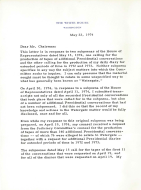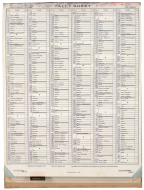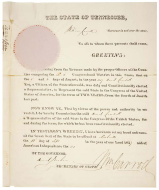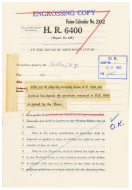On the Record: Featured Documents of the House of Representatives
A single piece of paper may not seem significant at first glance, but many of these featured records of the House of Representatives are examples of how one record can illustrate a much larger story. President Richard Nixon’s letter to Judiciary Committee Chairman Rodino refusing to comply with a subpoena issued for audiotapes and diaries related to the Watergate break in is an example of routine correspondence that encapsulates the downfall of a presidency. The tally sheet of votes for the declaration of war against Japan in 1941 is a seemingly innocuous clerical document that demonstrates the power of one woman voting her conscience. Without records like these, the context for historical events is lost. History is in the records.
Recently Added Featured Documents
Featured Document Archive
President Nixon Watergate Letter
 /tiles/non-collection/n/nixon_rodino_1_nara.xml
/tiles/non-collection/n/nixon_rodino_1_nara.xml
In 1974, the House Committee on the Judiciary, led by Chairman Peter Rodino, held an inquiry on whether President Richard Nixon should be impeached. The House has “the sole Power of Impeachment” under the Constitution (Article I, Section 2). In preparation for these proceedings, the Judiciary Committee served President Nixon with subpoenas for tapes and diaries relating to the Watergate break-in. President Nixon responded with two letters to Chairman Rodino outlining the reasons why he would not comply with the subpoenas.
More . . .
Image courtesy of the National Archives and Records Administration
Tally Sheet for the Declaration of War against Japan
 /tiles/non-collection/r/r_fc_japan_war_tally_sheet_na-at.xml
/tiles/non-collection/r/r_fc_japan_war_tally_sheet_na-at.xml
The Tally Clerk oversees the recording of votes and ensures the accuracy of the vote count on the House Floor. This tally sheet shows the votes for the declaration of war against Japan on December 8, 1941, taken after President Franklin Roosevelt delivered his “date that will live in infamy” speech. Jeannette Rankin, the first woman to serve in the House, is the only “nay” vote.
More . . .
Image courtesy of the National Archives and Records Administration
David “Davy” Crockett’s Certificate of Election
 /tiles/non-collection/r/r_fc_davy_crockett_credentials_na-at.xml
/tiles/non-collection/r/r_fc_davy_crockett_credentials_na-at.xml
David “Davy” Crockett is an American frontiersman whose folksy “backwoods” persona captured the American popular imagination. He became a legend with his death in 1836 at the famed battle of the Alamo at the hands of a Mexican garrison. This certificate of election was issued in 1827 by the state of Tennessee to Congressman Crockett after his election as a Jacksonian to the U.S. House of Representatives. When a representative, delegate, or resident commissioner of the U.S. House of Representatives is elected to office, a certificate of election is issued as proof that the Member-elect is entitled to the seat.
More . . .
Image courtesy of the National Archives and Records Administration
Engrossed Bill, Voting Rights Act of 1965
 /tiles/non-collection/r/r_fc_engrossed_bill_voting_1965_na-at.xml
/tiles/non-collection/r/r_fc_engrossed_bill_voting_1965_na-at.xml
This featured document is the House’s engrossed copy of the bill for the Voting Rights Act of 1965, which has been reconciled by substitute, meaning that the full text of the bill that passed the Senate (S. 1564) is being replaced by the version of the text that passed the House as H.R. 6400 on July 9, 1965, after five weeks of debate. The Constitution requires that both Houses of Congress pass identical versions of a bill before it can be enacted into Public Law by the president’s signature.
More . . .
Image courtesy of the National Archives and Records Administration
 /tiles/non-collection/n/nixon_rodino_1_nara.xml
/tiles/non-collection/n/nixon_rodino_1_nara.xml
 /tiles/non-collection/r/r_fc_japan_war_tally_sheet_na-at.xml
/tiles/non-collection/r/r_fc_japan_war_tally_sheet_na-at.xml
 /tiles/non-collection/r/r_fc_davy_crockett_credentials_na-at.xml
/tiles/non-collection/r/r_fc_davy_crockett_credentials_na-at.xml
 /tiles/non-collection/r/r_fc_engrossed_bill_voting_1965_na-at.xml
/tiles/non-collection/r/r_fc_engrossed_bill_voting_1965_na-at.xml









 ;
;
 ;
;
 ;
;
 ;
;